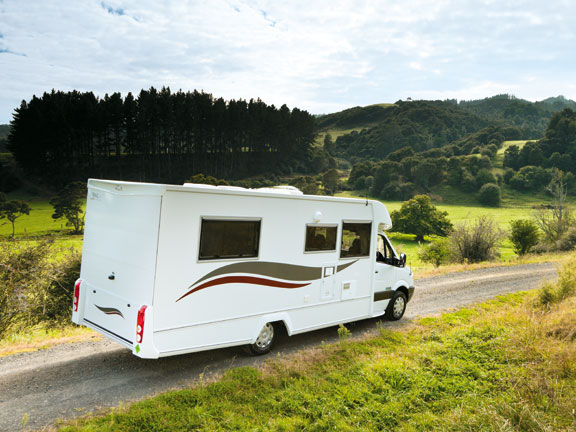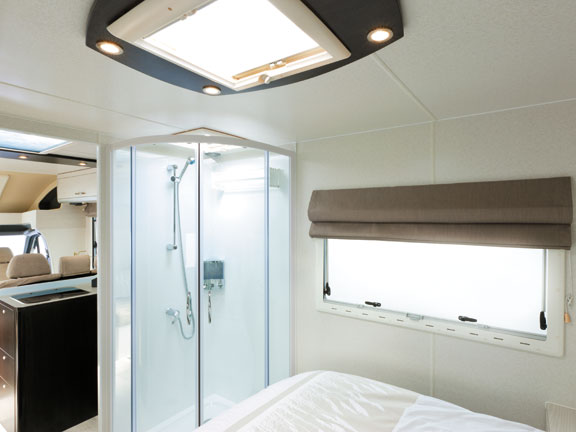- Wide interior and spacious bedroom
- Best interior décor available
- Facilities allow for freedom camping
- Dynamic chassis and performance
- Extensive options list
Trail-lite is as known for its upper echelon pricing as for the quality of its product, and its understandable of course – you don’t get a Ferrari for Ford money after all. Predictably then, Trail-lite’s latest low line range kicks in at a relatively heady $181,280 for the Base Camp model, and works its way up from there to the completely individualised Landmark models which start at $215,000.
With around 70 percent of Europe’s motorhome market consisting of the easy to store, easy to drive low line style vehicles, it’s no wonder the concept has revolutionised the industry here, with all the key players now developing vehicles of this nature.
Trail-lite’s manager, Shaun Newman, admits there’s a lot to learn out of Europe.
“Obviously we’ve made a living from caravans and mostly larger, class two motorhomes, but we travelled to one of the biggest motorhome shows in Europe and took over 300 photographs of designs, innovations and accessories that we thought would work well on our low line series. We think we’ve got the best of both worlds – the layouts and features popular with European product and our own interior design and building philosophies.”
European influences are manifested in the low line range with an all new, aerodynamic Luton moulding unique to Trail-lite (standard on Landmark, optional on Base Camp), a large curved Luton window, a distinct focus on the bedroom and bathroom and less room devoted to the kitchen.
Meanwhile, all the things that have made Trail-lite a popular brand are also evident – it’s as wide as New Zealand legislation will allow, the body sides are the tough Alu-fibre product unique to the brand, minor side extrusions are also aluminium – no plastic trimmings here.
Even at Base Camp level the interior is beautiful, with internal space being the obvious distinction between imported models. It’s wider than most and there’s a generous walk-around space that seems all the more impressive with the added light from that huge front window overhead. Move up to Landmark level, however, and the interior options that face you are numerous, and all of them stunning.
As with the larger Trail-lites, Landmark owners have a one-on-one consultation with the in-house interior designer to work out a completely personalised layout and colour palette to suit. All of the modern colour treatments, ash-hues wood grains or lacquer-coated cabinetry are among the best you’ll find anywhere.
But honestly, the Base Camp remains a very well appointed vehicle.
The north-south orientated rear island is sizable, with cabinets and room to climb in and out either side. Forward of the plush sleeping quarters are the separate toilet and shower facilities, which can be closed off from the main living area.
The kitchen – at least in this floor plan – is a departure from previous Trail-lite “big is good” ethos. It’s not a vast area of bench space and cupboards, but Trail-lite’s anecdotal research with buyers suggests this isn’t the big deal it once was, particularly in these style vehicles.
You can specify alternative layouts, but the L-cove kitchen is one of my favourite infiltrations from Europe. Should you wish for more kitchen space you’ll have to compromise in bed / bathroom layouts, but Shaun says this floorplan seems to be the one everyone is going for.
Rather than cupboards, everything is stowed in drawers to optimise every last inch of space. The pantry is a slide-out vertical drawer that provides room for tinned goods and all the essentials. All the drawers lock automatically on start-up via a central locking system.
Despite the more compact kitchen you still get a full-size fridge, so the low line’s food storage and water supplies (fresh/grey water tanks are 200 litres) still facilitate freedom camping for around five-day stints without a problem.
The move toward the Mercedes Sprinter base is another point of difference over most low line style motorhomes, but it’s the best fit for Trail-lite both in practicality and perception.
“Being front-wheel drive, the Ducatos are a bit easier to build on, but we’ve used the Sprinter a lot previously so our team is very familiar with it, it’s definitely our preferred base vehicle,” says Shaun. “And sure, we had an existing relationship with Mercedes-Benz, which helps, but also the Sprinter is a little more expensive and perceived to be a premium option over other products. Obviously there are synergies with our brand there too. People also like the rear wheel drive platform.”
The muscular Sprinter boasts a potential GVM of five-tonnes, so you can load it to the gunnels and still never worry about over-stressing the power unit. Perhaps most importantly, there are 22 service agents nationwide so you’re never far from an expert for maintenance or repairs.
With the top-of-the-line V6 CDi engine variant developing 140kW of power and 440Nm of torque you’ll be impressed with the performance that’s available, and that aerodynamic Luton reduces wind noise and improves economy. Further on the technical front there are the latest high performance self-sufficient power systems on board, including 85 watts of solar and 260-amp hour batteries all monitored by the Red Arc intelligent charging system.
With the quality enhancements Trail-lite has introduced to its RoadCraft camper range and now the spacious and beautifully-appointed low line series, the brand has proven the core principles you’ll find in its king-size models work just as well in scaled-down form.
Specifications
Engine 3.0-litre V6 turbo diesel
Power 140kW @ 3800rpm
Torque 440Nm @ 1600rpm
Transmission Six speed automatic
Length 7800mm
Width 2450mm
Fresh water 200 litres
Grey water 200 litres
Cooker Four-burner stove/full oven
Fridge 175 litres
Power supply 85-watt solar/260-amp hour battery/ intelligent charging/monitoring system













